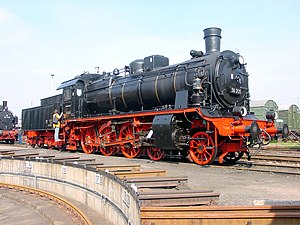This article includes a list of references, related reading, or external links, but its sources remain unclear because it lacks inline citations. (September 2016) |
The Saxon Class XII H2 steam locomotives (also nicknamed Sächsischer Rollwagen or 'Saxon rollers') were bought by the Royal Saxon State Railways (Königlich Sächsische Staatseisenbahnen) specifically for the mountainous areas of Saxony. They were built by Hartmann between 1910 and 1927 in Chemnitz. The design of this passenger train locomotive was carried out in parallel with that of the express train classes, the Saxon X H1 and Saxon XII H. A total of 159 examples of this powerful locomotive were built by 1922.
| Saxon XII H2 DRG Class 38.2-3 | |||||||||||||||||||||||||||||||||||||||||
|---|---|---|---|---|---|---|---|---|---|---|---|---|---|---|---|---|---|---|---|---|---|---|---|---|---|---|---|---|---|---|---|---|---|---|---|---|---|---|---|---|---|
 Steam locomotive 38 205 (sä XII H2) at Chemnitz-Hilbersdorf Railway Museum on 24 August 2002 | |||||||||||||||||||||||||||||||||||||||||
| |||||||||||||||||||||||||||||||||||||||||
| |||||||||||||||||||||||||||||||||||||||||
| |||||||||||||||||||||||||||||||||||||||||
The Deutsche Reichsbahn took over 124 of these engines as the DRG Class 38.2-3 (the others had been lost during the First World War or had to be given away as reparations) and gave them operating numbers 38 201 to 38 324. In 1927, ten more were built. These were given operating numbers 38 325 to 38 334.
During the Second World War 15 of the Class XII H2s that had been given to France returned to Germany and were stationed again in the Reichsbahn division of Dresden. From 1938, however, the majority of these locomotives were working out of locomotive depots (Bahnbetriebswerken or Bw) in the Sudetenland. As a result, after the war only about a half the original fleet of these engines was left in Germany. Five of the locomotives returned from France went into the East German Deutsche Reichsbahn where they were allocated operating numbers 38 204 and 38 351 to 38 354. The last ones had been withdrawn by 1971.
Even the surviving museum locomotive, number 38 205 is currently not working. This engine is owned by the DB Museum at Nuremberg and has been loaned to the Saxon Railway Museum in Chemnitz-Hilbersdorf.
The first 15 vehicles were originally equipped with Saxon sä 2'2' T 16 tenders. Later they ran with Saxon sä 2'2' T 21 tenders as did all the subsequent locomotives.
See also edit
References edit
- Heinrich, Peter (1983). Die Baureihe 38.2 (in German). Freiburg: EK-Verlag. ISBN 3-88255-382-0.[page needed]
- Näbrich, Fritz; Preuß, Reiner; Meyer, Günter (1984). Lokomotiven sächsischer Eisenbahnen, Schnnellzug- und Personenzuglokomotiven (EFA 2.1) (in German). Düsseldorf: Alba. pp. 175–182, 213. ISBN 3-87094-096-4.
- Reiche, Günther (1998). Richard Hartmann und seine Lokomotiven (in German). Berlin/Chemnitz: Oberbaumverlag. ISBN 3-928254-56-1.[page needed]
- Vandenberghen, J. (1989). La guerre 1914 - 1918 et les locomotives "Armistice", 3. Description des locomotives bavaroises, saxonnes, badoises, mecklebourgeoises, oldenbourgeoises (PDF) (in French). Brussels: SNCB. p. 35.
- Weisbrod, Manfred; Müller, Hans; Petznik, Wolfgang (1976). Dampflokomotiven deutscher Eisenbahnen, Baureihe 01–39 (EFA 1.1) (in German) (3rd ed.). Düsseldorf: Alba Buchverlag. pp. 221–223. ISBN 3-87094-081-6.